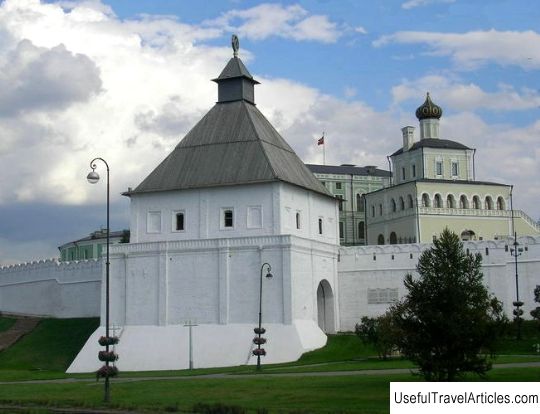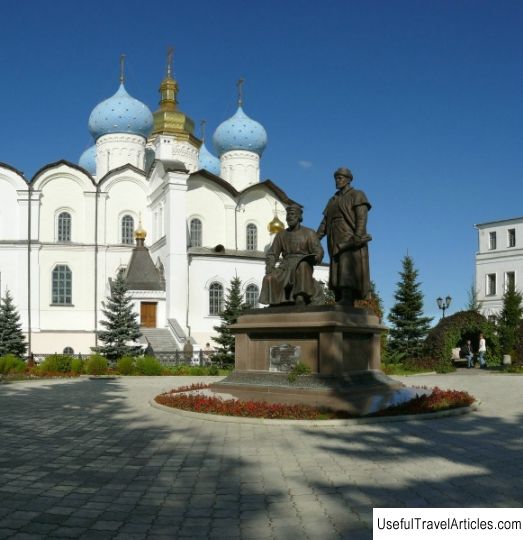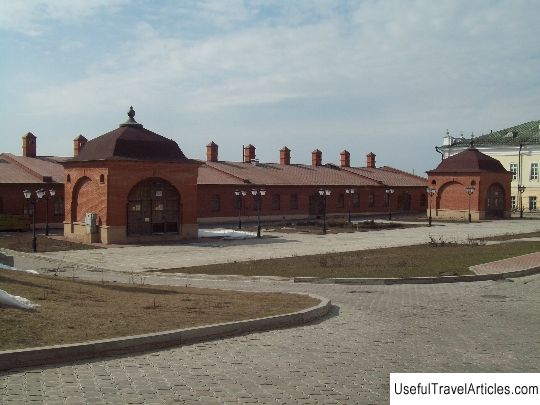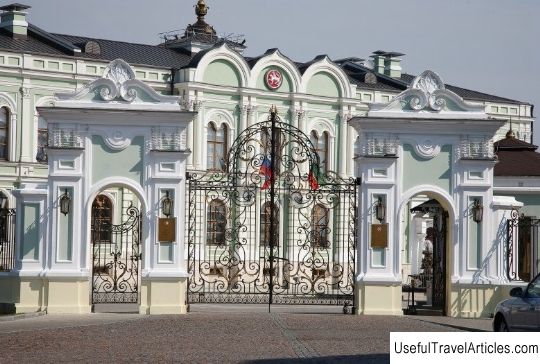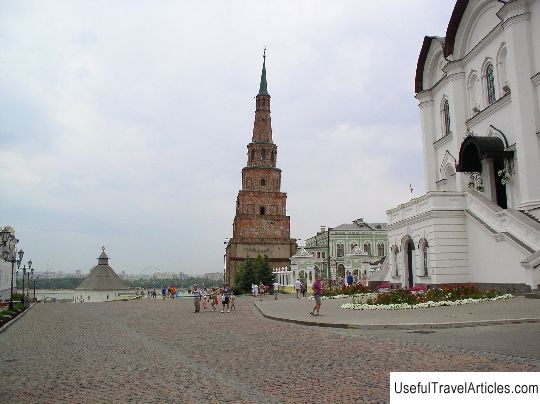Kazan Kremlin description and photo - Russia - Volga region: Kazan
Rating: 8,4/10 (3421 votes) 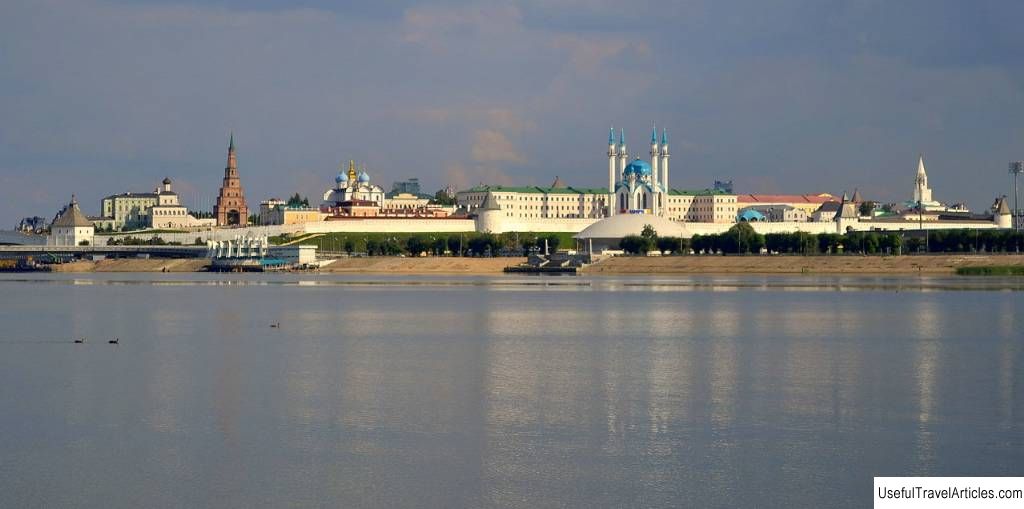
Kazan Kremlin description and photos - Russia - Volga region: Kazan. Detailed information about the attraction. Description, photos and a map showing the nearest significant objects. Photo and descriptionThe Kazan Kremlin is one of the most beautiful and unusual in our country. It reflects the multifaceted history of the city; mosques and monasteries, old and new buildings, museums and exhibitions of contemporary art are adjacent to it. The Kazan Kremlin, restored and decorated for the 1000th anniversary of the city, has become one of the most attractive tourist sites in the country. History of the fortressThe very first settlements on the territory of the Kazan Kremlin belong to the Mesolithic. But present-day Kazan dates back to the Bulgar settlement of the 10th century - its remains were found in the northern part of the Kremlin hill. A stone fortress stood here already in the XII century. After the Golden Horde disintegrated, Kazan became the center of one of the states that formed on its basis - the Kazan Khanate. In 1552 the city was taken by Ivan the Terrible. The current walls and towers of the Kazan Kremlin were built almost immediately after the conquest - in 1556-62. on the basis and using materials of the Tatar fortress, dilapidated during the assault. Initially, there were 13 towers, and a drawbridge across the moat led to the city from the Kremlin. Ammunition rooms were arranged in the six-meter walls. This fortress was built so as to withstand and conduct artillery fire. Five of the towers were dismantled in the 19th century - now their foundations are open for inspection, but in general the Kazan Kremlin is very well preserved. The last restoration took place here at the end of the XX - beginning of the XXI century to celebrate the millennium of the city: the towers were returned to the wooden sheds, and this returned the appearance of the fortress, close to the historical. < h3> Kul-Sharif Mosque The main attraction of Kazan and the architectural dominant of the Kremlin complex is the most beautiful mosque Kul-Sharif. Once at about this place in the capital of the Kazan Khanate there was a legendary mosque with many minarets, which was considered the most beautiful - in any case, this is exactly how it is mentioned in written sources. But the mosque was destroyed in 1552, and no images or drawings remained of it. In memory of her, a new mosque was built in 1996-2005. It was named after Kul Sharif, the spiritual leader of the Kazan Khanate in the 16th century. This is one of the tallest and largest mosques in Russia. The height of its minarets is 58 meters, and the height of the dome is 39 meters. It is faced with Ural granite and white marble, richly decorated inside and out, and the evening lighting makes it especially impressive. There is a Museum of Islamic Culture at the mosque, which occupies two halls. One room tells about Islam in general - for example, there is a model of Mecca, and the second tells about the history of Islam in Tatarstan. The museum organizes exhibitions, excursions and master classes. Syuyumbike TowerThe second building in the Kremlin, which cannot be missed, is the seven-tiered Syuyumbike Tower - it is almost the same height as the minarets and is "Pisa", that is, stands at a noticeable slope. There is no exact dating of its construction, scientists hesitate between the 16th and 18th centuries. The 19th century legend connects it with the name of Queen Syuyumbike, which ruled Kazan at the time of the capture of the city by Ivan the Terrible and rushed from the highest tier of the tower so as not to get the Russian tsar. The tower is not connected with the Kremlin walls - this is a rather rare type of watchtower, which is not outside the fortress, but inside it. Cathedral of the Annunciation Kazan is a city of two verses, so not less impressive, but more ancient Annunciation Cathedral is located not far from the mosque. It was built in the 16th century. Initially, the Moscow Assumption Cathedral was taken as a model, although it is difficult to guess the prototype from the current appearance of the main Kazan temple. This temple was built by the famous Moscow architects Barma and Postnik - the same who built St. Basil's Cathedral in Moscow. A fragment of the painting has survived since that time - the Kazan icon in the altar of the cathedral. The temple received its current forms, with the baroque completion of the central dome, during the rebuilding in the 18th century, and in the 19th century it was still significantly expanded. Its five-tiered bell tower has not survived. Valuables from the sacristy of the cathedral, confiscated by the Bolsheviks - the precious frames of the icons, the Gospels, decorated with rich miniatures - were mostly plundered. What has survived is now in the National Museum of Tatarstan, located near the Kremlin. During the Civil War, the cathedral was badly damaged - the Red Army fired at the city, several shells hit the cathedral. In Soviet times, the building belonged to the State Archives. In 1970-80s. the cathedral was restored - so as it was in the middle of the 19th century, and since 2005 it has been handed over to believers again. The main shrine of the cathedral before the revolution was the relics of St. Guria, the first Kazan archbishop, has now restored his cancer here, and a particle of holy relics has been returned. The Museum of the History of the Annunciation Cathedral operates at the cathedral. This is an interactive exhibition telling about the history of Orthodoxy in Kazan and the decoration of the cathedral - the way it was before the revolution, and the way it is now. Some relics are kept here: for example, the staff of St. Guri, a model of the carriage of Empress Catherine II, icons and books from the lost cathedrals of the Kremlin, and much more. Spaso-Preobrazhensky MonasteryAnother important part the Kremlin is a complex of buildings of the Spaso-Preobrazhensky Monastery. It was founded immediately after the capture of Kazan, in 1556. The Transfiguration Cathedral was built at the end of the 16th century. Under his altar was the tomb of the Kazan bishops and nobility. At the same time, the Church of Nikita Ratny appeared, and at the beginning of the 19th century, the famous Kazan Theological Seminary moved to this monastery. The Transfiguration Cathedral has not survived to this day - only a part of the basement remained, but the Church of Nikita Ratny was restored. Now this complex is being restored and should become a museum of archeology. Administrative buildings and the Cannon yard In the 18th century, a public office building appeared in the Kremlin. It was built in 1756 by the architect V. Kaftyrev. This is a two-story building with vaulted cellars, which is divided into three sections, separated by driveways. Then, in the 17th century, on the site of the former khan's palace, the house of the chief commandant was built. By the 19th century, it was dilapidated. Already in the 1840s, a new pompous building appeared here. This is the house of the military governor, built according to the project of the most famous architect of the Nikolaev time - K. Ton. Its architecture combines classicism with oriental and Byzantine motives. It has always retained its administrative function: in Soviet times, the Council of Ministers was located here, and now it is the residence of the President of the Republic. Kazan once housed one of the largest arsenals in Russia - centers for the manufacture and repair of weapons. By the middle of the 19th century, its activities ceased, but the complex of its buildings remained. After restoration, one of its buildings became a museum center - events, performances and temporary exhibitions are held here, and it is positioned as the Museum of Weapons. The remains of the foundry have been preserved here. Museum of Statehood of TatarstanNot far from the governor's house there was a house church - first Vvedenskaya, and after perestroika in the middle of the 19th century - the church of St. Spirit. Now it has been restored, and it houses the Museum of Tatarstan Statehood. The first floor of the building is occupied with exhibitions, mainly from the funds of the National Museum, telling about the history and culture of the country, and the second is the main exposition - about the formation of statehood, Bulgaria, the Golden Horde, the Kazan Khanate and Russia. It is designed with modern interactive elements: here you can listen to audio information, watch videos, there are installations and touch panels. Junker School and Art Gallery In 1866 the Kazan cadet school was organized. It is located in the Kremlin - in a building that used to be the cantonist barracks. Then the building was two-story, in Soviet times a third was added to it. Now there is an art gallery of the republic. Here are collected works of Kazan artists from the 19th century. The museum occupied three floors: two floors for the main exposition and a floor for temporary exhibitions. The gem of the exposition is the largest collection of works by the most famous Kazan artist, Nikolai Feshin. He taught at the Kazan Art School, but in 1923 he emigrated to the United States and lived there for the rest of his life, so Americans consider him their artist. According to his will, he was buried in his homeland - in Kazan. In addition to his works, there are works of the Kazan avant-garde school, and many paintings by contemporary artists on national themes. Museum of Natural History of TatarstanAn interesting natural science museum telling about the history of the formation of the Earth and the emergence of life on it, it is also part of the Kazan Kremlin. Here is a collection of minerals from the Geological Museum of Kazan University, paleontological exhibits - for example, the colorful skeleton of a Tyrannosaurus, volcano models and much more. The museum is designed primarily for schoolchildren: there are many different interactive and multimedia elements that will be of interest to children. Some of the exhibits are playable - you can touch them and carry out experiments with them, models of volcanoes operate, and dinosaurs move. Interesting facts
            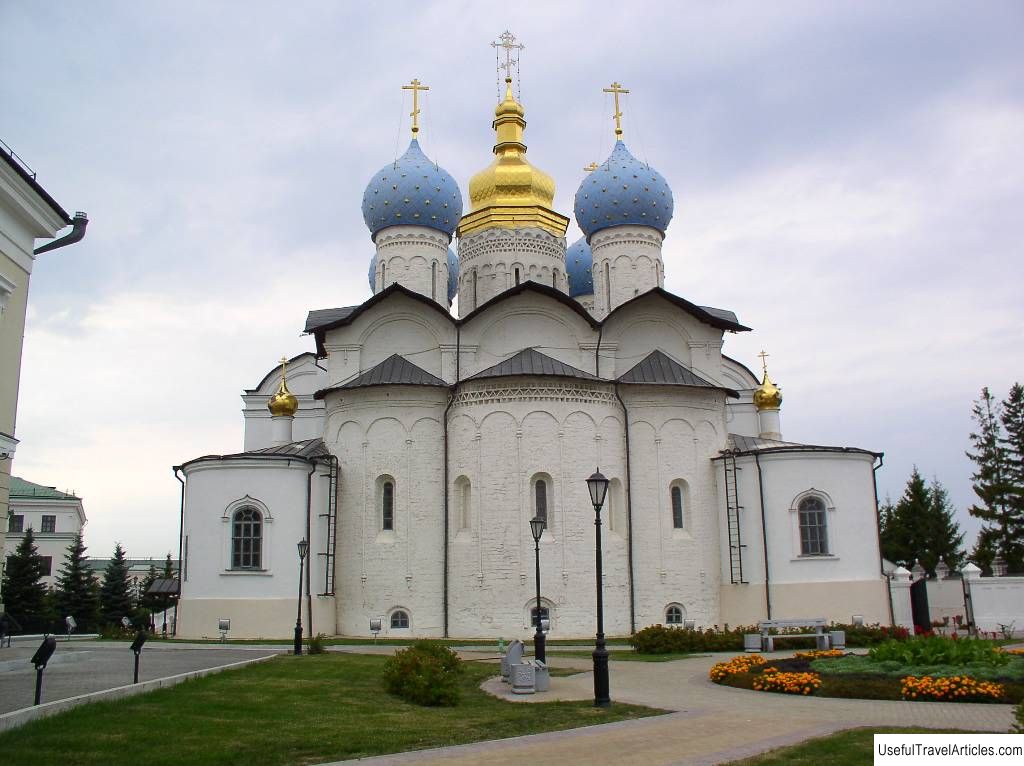                        < img src="/preload.png" data-src="/uploads/posts/2019-06/travel-image-6010.jpg" itemprop="image" border="0"> < img src="/preload.png" data-src="/uploads/posts/2019-06/travel-image-6010.jpg" itemprop="image" border="0">        < img src="/preload.png" data-src="/uploads/posts/2019-06/travel-image-6034.jpg" itemprop="image" border="0"> < img src="/preload.png" data-src="/uploads/posts/2019-06/travel-image-6034.jpg" itemprop="image" border="0">        < img src="/preload.png" data-src="/uploads/posts/2019-06/travel-image-6052.jpg" itemprop="image" border="0"> < img src="/preload.png" data-src="/uploads/posts/2019-06/travel-image-6052.jpg" itemprop="image" border="0">  We also recommend reading Lake Pleshcheyevo description and photo - Russia - Golden Ring: Pereslavl-Zalessky Topic: Kazan Kremlin description and photo - Russia - Volga region: Kazan. |
